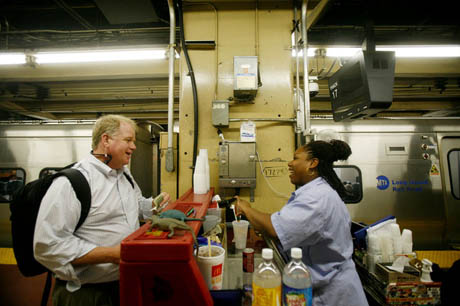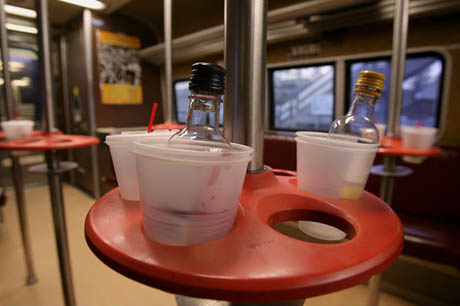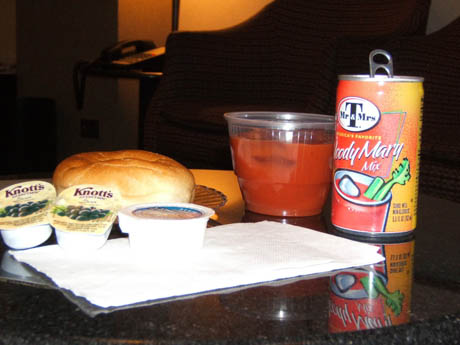Today’s New York Times has a fascinating story on the relative popularity of different drinks on the Long Island Rail Road (LIRR) and Metro-North New York City commuter train routes.

IMAGE: “Tracy Bonner, right, sold a drink to Kevin Davies of Port Washington on the Long Island Rail Road track at Penn Station.” Photo by Kirsten Luce for The New York Times.
Both sets of passengers clearly appreciate a wee drop to help them relax and unwind after a hard day. “Last year,” journalist Michael Grynbaum writes, “passengers bought nearly three million drinks and snacks from commissary carts and bar cars run by the railroads, generating $9 million in revenue.”
The most popular beverage is beer, which accounts for half of all alcohol purchases. And Bud is, as they say, the king: Grynbaum reports that “Budweiser and its calorie-conscious cousin, Bud Light, make up about 45 percent” of all beer sales.

IMAGE: The bar car on a Metro North train. Photo by Michelle V. Agins for the The New York Times, to accompany another article by Michael Grynbaum, this time on threats to the bar car’s future.
In terms of spirits, vodka is the runaway top-seller on both services, with an anonymous bartender letting slip to the Times that “stockbroker customers ‘all drink vodka,’ while construction workers ‘are all about the beer.'” On both lines, white wine is preferred over red “by a two-to-one ratio” — perhaps due to eminently sensible concerns about spillage.
The bulk of the article, however, is devoted to teasing out the differences between the two sets of drinking data. Why, for example, are light beer and regular Coke proportionally more popular among LIRR riders, while Metro-North rider like to chug full-calorie beers, but then for the most part order diet soft drinks? To add to that, Grynbaum notes that “blush varietals were three times as popular among Long Islanders,” opening the door to rampant speculation and latent snobbery.
Buried in these kinds of discrepancies, are there, as the Times suggests, clues about “the cultural divide that separates points north and east of Manhattan?”

IMAGE: Spicy tomato juice, as ordered by almost everyone who sits next to me on a plane lately.
The rest of the article is well worth a read, but it also led me to wonder about beverage differentiation on airline routes.
While much has been made online about ginger ale’s unexpected aerial dominance (apparently one in ten drinks ordered in economy on American Airlines is a ginger ale, compared to its puny three percent terrestrial market share), there seems not to be a sustained geographical analysis of the beverage consumption patterns on different routes and airlines — or even different seat positions. Do window-seat people disproportionately favour vegetable juice, for example, or is that just the case on the routes I’ve been flying?

IMAGE: Ginger ale finds its spiritual home.
Although passenger consumption data is not freely available, it was intriguing to see that airlines do at least differentiate their offerings by destination and brand. For example, United offers themed Trader Vic’s Mai Tais exclusively on flights to Pacific destinations, while only Hawai’i-bound Alaska Airlines passengers can purchase Kona Longboard Island Lager. Meanwhile, business-friendly Continental sticks to tried and true cocktails (vodka and Red Bull is as racy as it gets), while upstart Virgin America boasts about its cheeky “Mile-High Cocktail” that includes “authentic French absinthe.”
Delta’s “It’s Five O’Clock Somewhere” cocktail, however, is my favourite airline offering: while its orange and cranberry juice-derived Vitamin C offers a prophylaxis against the germ-laden recycled air and its lime garnish harks back to the age of slower travel (and scurvy), its geographical insouciance seems perfectly suited to treat contemporary long-haul dislocation.
Perhaps, after all, these drink choices say less about the socio-cultural preferences of a particular demographic than they do about the psychological weight and potential hazards of the route. A Bud Light on your ride back to Hunters Point Avenue, or a cocktail named after a Jimmy Buffet song drunk at the back of a Boeing 747, can serve as the appropriate strategic — even spiritual — fortification for the trip. Whether it be the British Navy issuing its sailors a daily tot of rum, John Glenn requesting Tang for his return to space, or even Amazonian shamans ingesting ayuhuasca in order to voyage into the soul, different journeys call for different types and degrees of liquid reinforcement.
Which brings me back to the New York Times article, in which Grynbaum quotes Maureen Michaels, chairwoman of the Long Island Rail Road Commuter Council, speculating as to why her fellow travelers might require hard liquor in greater quantities than their Metro-North counterparts. LIRR is simply a tougher commute: “On Metro-North, she said, ‘the trip is shorter, the on-time performance is better.'”

